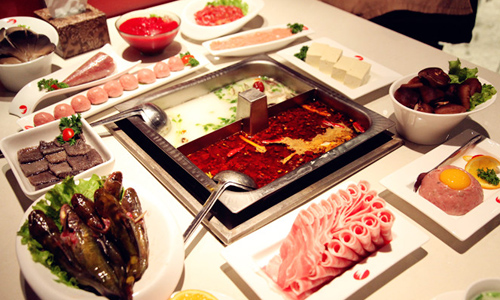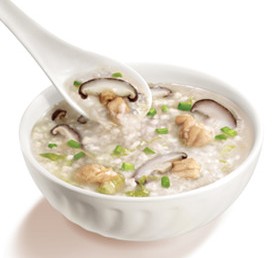Recently the very successful Chinese chain of hot pot restaurants, Hai Di Lao 海底捞 opened a restaurant in the affluent Los Angeles neighborhood of Arcadia. It has over 75 restaurants in China.

The concept of hot pot is like fondue, but instead of wine-spiked cheese, various forms of broth - from tongue-numbing spicy to a more mellow herbal broth - are brought to boil to cook an array of meats, seafood, vegetables, bean curd and noodles, which are then dipped in various sauces and eaten.
Hai Di Lao, which began in Sichuan in 1994 and opened its first international branch in Singapore last year, brings a VIP element to the hot pot tradition. Customers are treated to a variety of benefits and services, which help appease potential frustration over wait lists for tables that can average 50 to 75 parties during peak hours.
While they wait, patrons can nibble unlimited free snacks, check e-mail at Internet terminals, play chess or other board games, or get pampered with a shoeshine, manicure or hand massage.
In the dining room, customers are treated to hot towels, eyeglass wipes to clear away fog build-up, hair ties, plastic bags to protect cellphones from hot pot splatter, and the highly entertaining “noodle dance”.
Noodle masters train an average of four to six months before they perform great acrobatic feats with lumps of dough.
Through choreography reminiscent of a rhythmic gymnast wielding a fluttering ribbon, a noodle master stretches the wedge into a long, thin continuous noodle by whipping and swirling the dough around in the air. The noodles are eventually tossed into the broth.
However, recent reports of customer comments were negative to this first opening with comments of high prices, manicurists offered in a restaurant and service complaints. Most of these are standards proven to be successful in China, so why are they not accepted in North America?
This is not surprising as I am sure that the clients in California would include a wide array of cultures. Although there is a large ethic Chinese population, I would guess that the majority of customers would certainly be non-Chinese. The key for success of any ethic restaurant would be to be authentic but also be acceptable to local cultural norms.
Most Chinese restaurants have a high service standard where the server stands at your table holding his or her order taking pad or device waiting for your order as soon as you sit down. In most western establishments, this is considered rude and “rushing” the customer. But in China, service is expected to be fast and people are in a hurry. Restaurants are busy and have a high turnover rate. Customers accept this and believe that this means food is good and fresh.
North Americans feel that dining out is a leisure activity to be enjoyed and not to be rushed. It is a chance to be with family and friends and shared conversation and ideas. Usual discussion at a Chinese restaurant is loud and tables are closer together, dishes come out from the kitchen like a machine gun and in no time, you are told all dishes are complete.
This reflects the cultural pace of the two societies. China is experiencing tremendous growth, everything is fast paced and very competitive. Have you ever noticed that in an elevator in China, everyone pushes the close door button – not just once but several times? I was recently home in Canada and while in an elevator, I paid attention to the passengers. No one pushed to the close door button; they were more inclined to push to “open door” button to ensure the passengers entering had enough time. In fact some elevators did not even have a close door button.
In China, I noticed that some newer elevators have the ability to cancel floors if you hit the floor button twice. Everything is a much faster pace.
Different food items also need to be considered when trying to introduce traditional Chinese cuisine into western tastes. In China, animal offals or internal organs are considered a delicacy but you would have a difficult time convincing local westerners to accept this. Cooked blood from pigs, chicken, duck and lamb are a treat for most Chinese when they have hot pot or other types of dishes. Also intestine, lung, stomach and esophagus are very acceptable and usually high priced. But in America, these items are usually discarded or used for pet food.
In North America, you will never see chicken or duck heads served with the meat dish; or even fish head with the fish dishes. The westerners are just not used to this. However in China, this is common practice and shows that the dish is fresh.
I have also heard from my Chinese friends that they find western food to be bland and no taste when compared with the pungent flavors of Chinese cuisine, especially northern and Sichuan cuisine. Have you tried the Sichuan dishes: Boiled Fish - Shui Zhu Yu水煮鱼 and Chili Frog - Chan Zui Wa馋嘴哇. Don't let the sight of the red chili peppers scare you. Once you avoid eating the peppers, the flavor is incredible and you can understand why the Chinese have a problem with sinking their teeth into a fried steak and potatoes. On the reverse, if you can imagine if you have been raised on meat and potatoes, Ma La Hot Pot 麻辣火锅a hot-numb spicy hot pot should not be the first try at a Chinese cuisine experience.
Obviously there needs to be a compromise to local tastes in order to gain general acceptance from local consumers. I find that more Chinese restaurants are accommodating and if you ask for them to use less salt and oil 少盐 - 少油and no MSG bu fang wei jing不放味精, they are willing to pass this instruction to their cook. There are also levels of spicy: little – Wei La 微辣, Medium – Zhong La 中辣 and Very -Zhong La 重辣.

There are also examples of western chains adapting to the Chinese market successfully. You won't find congee and black tree fungus on the menu at a KFC in North America but these are popular items in their China stores. Pizza Hut also has expanded into China, although Chinese are not used to eating chees products, a milder local chess and a heavier bread dough crust with local toppings is proving to be popular for local consumers.
I think there are great opportunities for Chinese snacks and specialty foods to be marketed successfully in the North American market. I love the local northern style pancakes or Jian Bing 煎饼 and dumplings: Tianjin's Gou Bu Li 狗不理and boiled dumplings: Shui Jiao 水饺and fried dumplings: Guo Tie锅贴.
One of the popular lunch trends for fast food are hot dogs stands or fish and chips stands, where workers can grab a meal for less than $10 and less than 10 minutes in the downtown core near the office towers. I can see my local pancake wagon along side selling a Jian Bing for 4rmb (75cents) and turning them out in less than a minute. We just have to cope with the health authorities and the -30 degree winters.
- Americas@zhaoshang.net
- +86-21-68911976
- tjfdiAmericas
- European@zhaoshang.net
- +86-21-68911976
- tjfdiEuropean
- Asian@zhaoshang.net
- +86-21-68911976
- tjAsian
